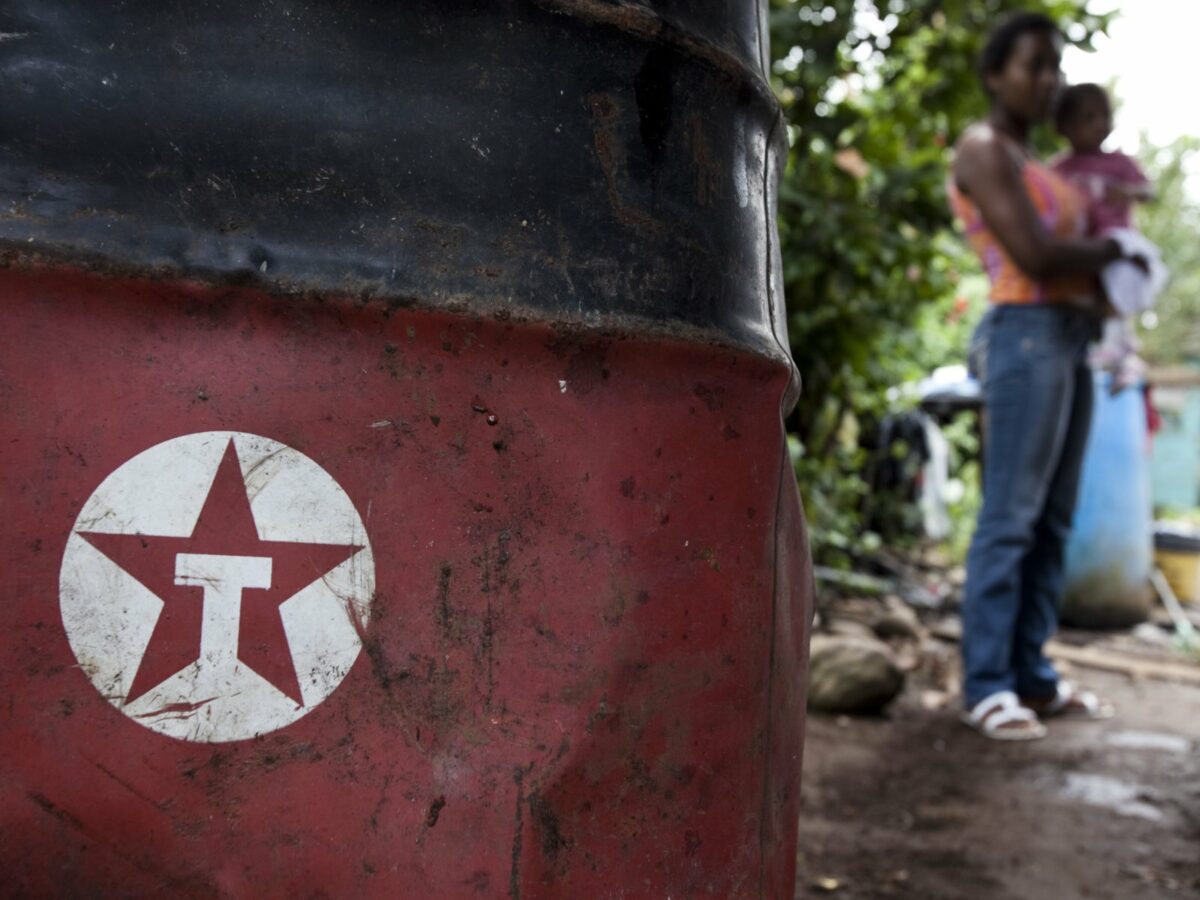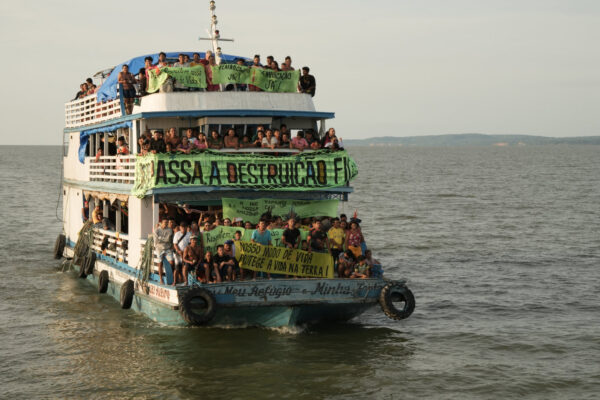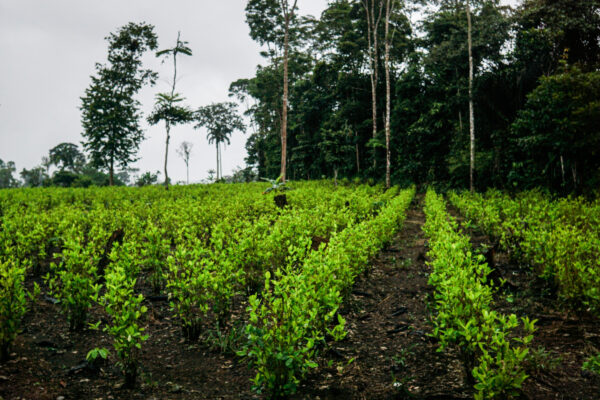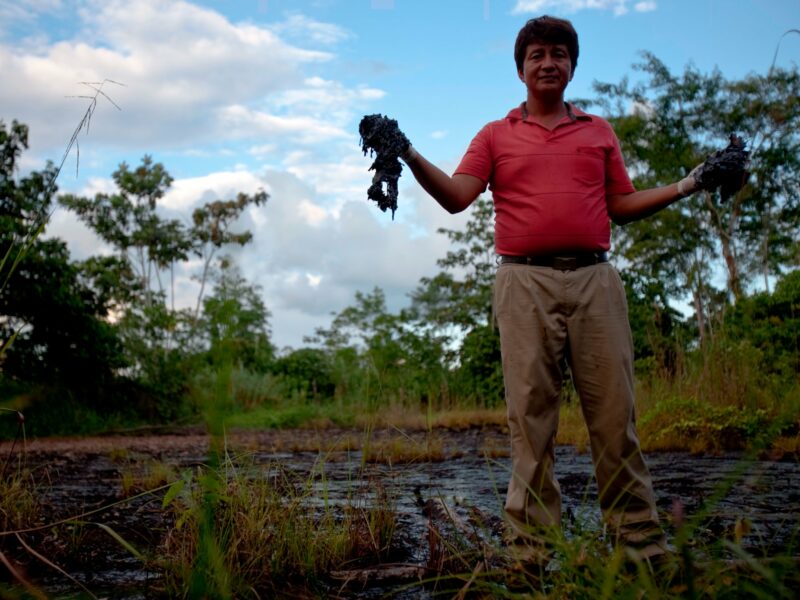“There’s a pool here,” says Ermel Chávez, a representative of the Amazon Defense Front in Ecuador. Chávez plucks a long branch from a tree, crouches down, and uses it to clear the ground. He submerges the branch by making a hole in the ground and pushing down: 1 meter, 2, 3 meters — 10 feet deep now — and still he continues.
We’re in San Carlos parish in the canton of Joya de los Sachas, in Ecuador’s Orellana province. “There are pools up to 6 meters [20 ft] deep. There’s oil in here,” Chávez says as he pulls the branch out. It’s covered in a gray paste that smells strongly of fuel. A few meters away, cows are grazing.
The Sacha oilfield, awarded by former president Rafael Correa to the Venezuelan state-owned oil company PDVSA, is now under the administration of Petroecuador, the national oil company of Ecuador, and is the largest in the area. San Carlos lies directly in front of the oilfield’s Sacha Sur station.
Among the vegetation here, there are several pits — pools full of oil residue that were once covered with soil. “Fruit trees don’t grow here, and if they do, they don’t bear fruit,” say local community members.
“There is a layer of oil under here. The oil has solidified,” Chávez says, referring to the waste that fills the pools and showing a cacao tree whose growth he says has stagnated. “The problem with this type of contamination is that people generally use water wells here in the countryside,” he says, pointing to the nearest house, an abandoned one-story building about 20 steps away. The family that used to live there had to move, Chávez says, because the water from the well they relied on “is already poisoned.”
The oilfield is a 12-kilometer (7.5-mile) drive from Joya de los Sachas. The road is dotted with groups of workers from Petroecuador EP and several extraction wells that the locals call “dolls” because of their shape. Some are closed and abandoned.
This scene is one of many left behind by U.S. oil company Texaco, now part of Chevron, in the Ecuadorian Amazon. It’s one of the most widely known environmental disasters in the country, and perhaps even the world. In a lawsuit over the damage, Texaco reported opening 333 waste pits between 1964 and 1990, Chávez says, but when satellite images by the company were examined as part of the judicial inspection, “990 pools were discovered.”
According to official information from the Ministry of Environment, Water and Ecological Transition (MAATE) included in the database created for this special report, Texaco is responsible for 1,107 accumulated environmental waste sites: 608 in Orellana and 499 in Sucumbíos province. Throughout Ecuador, there are a total of 3,568 recorded “sources of contamination” from the oil and gas sector. Only 51% of these sites have undergone environmental remediation.
The data show that Texaco left behind 714 buried oil pools that have reemerged over the years. Another 374 sites were contaminated by runoff or spills. Some 19 of these are pits, according to the database created with information from the environment ministry. Both Texaco and state-owned Petroecuador, which now manages oil operations and inherited the 1,107 environmental liabilities, were required to remediate their share of the pools. However, Petroecuador has failed to do so, and Texaco covered up the pools, as stated in the judicial files of a lawsuit available through Ecuador’s Ministry of Foreign Affairs.
“What they did back then was more criminal than leaving the pools open, because they dumped mud on top and the pools remained, covered,” Chávez says. Over the years, oil residue and formation waters — the water that is naturally trapped in the pores of the rocks and which comes out together with the crude oil when extracted — have reemerged throughout Orellana and Sucumbíos. This has been denounced by members of the Amazon Defense Front and organizations such as Acción Ecological Action, the Pachamama Foundation, the Union of People Affected by Texaco (UDAPT), and others.
Since 1993, Texaco — acquired by Chevron in 2001 — has faced lawsuits in federal and international courts after the affected inhabitants sued the company for contaminating around 21,000 square kilometers (8,110 square miles), an area the size of El Salvador. This protracted litigation, largely through international arbitration, has not worked out in Ecuador’s favor, which may have to pay around $9.5 billion to Texaco/Chevron. Pablo Fajardo, president of UDAPT, a nonprofit, said former attorney general Íñigo Salvador “did a disastrous job, really disastrous, with the technical defense of Ecuador.”
According to a report by the organization Corporate Accountability, published in April 2023, Chevron is responsible for annual emissions equivalent to 364 coal-fired power plants, or “the total emissions of 10 European countries combined in a similar period.” UDAPT alleges Chevron dumped “60 billion liters [16 billion gallons] of rotten water, formation water and toxic water, and 650,000 barrels of oil” in the Ecuadorian Amazon. To date, there are more than 700 abandoned pools across the Ecuadorian Amazon that Chevron and Petroecuador are responsible for remediating.
Petroecuador, a nest of scandals
In Ecuador, the Organic Environmental Code (COA) describes an environmental liability as “damage generated by a work, project or productive or economic activity that has not been repaired or restored, or that has been addressed inadequately or incompletely and continues to be present in the environment, constituting a risk to any of its components.” Texaco never remediated the damage it caused, and the government, which inherited the environmental liabilities, has failed to sanction or remediate the damages or to compensate the thousands of victims.
Chávez says he believes the successive governments in Ecuador are accustomed to ignoring the problems. Although the damage is obvious, the authorities and most oil companies deny or downplay the damage by the oil industry to rivers and farmland. The damage has also altered the lives of thousands of Amazonian inhabitants without consideration for their opinion or attempts to obtain their free, prior and informed consultation, as required by the Constitution since 1998.
With the arrival of the first oil companies in the 1970s, several brothels opened up along the highways in Orellana and Sucumbíos. According to Chávez, there are more brothels today than pharmacies or schools in the area.
Additionally, at the edge of the tracks, there are a pile of rusty, patched and exposed pipes called “noodles,” still used to transport oil despite their poor condition. The pipes pose a permanent danger as they tend to heat up to scorching temperatures.
A few minutes into the canton of Shushufindi, in Sucumbíos province, is a local refinery where tankers load up on crude oil that then goes to the northwestern port city of Esmeraldas for export. At least one stack is lit at the facility, flaring off gas into the atmosphere.
Petroecuador, which took over from Texaco/Chevron, was responsible for 96.5% of the oil spills that occurred in Ecuador between 2021 and 2022, according to the environment ministry. The ministry said there had been no risk analysis of these damages in terms of health and safety or environmental quality. In an emailed statement, the ministry’s communication team said, “prioritization methodologies are being developed for interventions in areas possibly affected by the presence of contamination sources and/or environmental waste sites.”
However, the information from the ministry is contradictory when it comes to accounting for the damages caused by the oil industry. For example, spill data sent to Mongabay in March 2022 indicate that in 2021, there were an average of three oil spills a week in Ecuador. But in a later submission in October, the average number of spills per week during 2021 amounted to 11. The ministry had not clarified this contradiction as of the time this story was originally published by Mongabay Latam.
Petroecuador has said in repeated public statements that, between 2013 and 2022, it remediated 1.44 million cubic meters (51 million cubic feet) of soil, eliminated 1,127 sources of contamination, and recovered 49,040 barrels of oil. However, the company’s communications department did not respond to requests for information and interviews to corroborate this information.
Crossing the bridge over the river of La Victoria and past the northeastern parish of Limoncocha, one arrives at the Shushufindi 61 well of the Shushufindi field. Although exploration here began in 1971 and exploitation in 1972, a plaque riveted to the pipe gives the date of April 14, 1969. That same device has been in operation since then, and today, at one of its joints, oil is seeping and dripping onto the open ground. “It is producing,” say Wuilmo Moreta and Hermel Cabrera, two settlers who have lived in this area for more than four decades. A few meters away are the remains of deposited oil abandoned in excavated hollows.
“When they did the oil explorations, they used to make these open pits without any protection below,” says Juan Calva, a 52-year-old man who arrived here in the community of El Carmen from the southern city of Loja when he was 7 years old. “When they left, they left open pits with a large amount of oil. When it rains a lot, this fills up, begins to overflow and drains to the marshes and the estuaries.”
Along the road, Calva points to a thick, black and smelly paste. Walking through the terrain is almost impossible due to the abundant oil residue, which looks like black dough covering the muddy, shifting liquid. When Calva arrived, Texaco was already operating here, and he says he has since seen animals die and many of his friends and relatives fall ill.
Petroecuador, which inherited the remediation of these liabilities, is Ecuador’s largest state-owned company. It’s involved in the entire value chain of the oil and gas sector, including the refining process. However, the company is also plagued by corruption scandals. Since June 2021, Ecuador’s comptroller general ordered monitoring at Petroecuador and other state-owned companies. After 19 months, it issued 117 general audit reports, 75 of them regarding Petroecuador, and forwarded 23 reports on criminal responsibility to the Attorney General’s Office, of which 11 relate to the company.
On Feb. 17, 2023, the Comptroller General’s Office confirmed two cases of economic losses by a state-owned entity amounting to $4.7 million, to be paid by Petroecuador and a company called Geincosolution due to irregularities in contracts to replace equipment coating for the Trans Ecuadorian Oil Pipeline (SOTE). The comptroller’s report concluded that Petroecuador paid an excess of 290% to Geincosolution for the material used to replace the pipeline coating without any justification, costing the state $4.6 million more than it should have paid.
Another report of damages, for $147,893, was confirmed for unjustified payments. “The civil liability corresponds to the difference between the disbursements made by Petroecuador and the prices that the contractor paid to its suppliers for the items of pipe cleaning and sand bed,” the comptroller’s office said.
The comptroller also found that Petroecuador made undue and unsubstantiated payments to the company Nolimit for contracts at the Esmeraldas refinery, as published by the news site Primicias. In total, 21 company officials were implicated between 2016 and 2021.
On Feb. 3, the newspaper Diario Expreso published a report on two attempts by Petroecuador under two different administrations to hire personnel through outsourcing arrangements prohibited by the Constitution. The second attempt involved a contract that would take place one month later, in March. The latest cases of corruption at Petroecuador surfaced after an alleged influence-peddling network was uncovered at the end of January this year, which led to the company’s general manager, Hugo Aguiar, resigning.
Luis Verdesoto, the anticorruption secretary appointed by President Guillermo Lasso, presented a report revealing the existence of the corruption network with the cooperation of several public companies, including Petroecuador. Verdesoto resigned after presenting the report.
Cancer in the Amazon
“I have three relatives who died of cancer,” Juan Calva says. “My mother-in-law just recently died of cancer. She had been ill for a long time. She spent all she had to spend, but she was not saved. When the cancer was detected, it had already spread through her body.”
Calva is standing next to the remains of oil that have been there for over 40 years as he speaks. He also mentions a sister and brother-in-law who became sick, and recalls a colleague of his who died nine months earlier of stomach cancer but was given a COVID-19 diagnosis at the hospital.
“The lungs of the world have cancer,” says Ermel Chávez from the Amazon Defense Front. But in the Ecuadorian Amazon, there are no official records of the disease’s incidence. The only extensive record of cancer incidence in the entire region, besides a few isolated comparative studies, is the famous Yana Curi report, subtitled “Impact of oil activity on the health of rural populations in the Ecuadorian Amazon,” published by physician Miguel San Sebastián and the Manuel Amunárriz Institute of Epidemiology and Community Health in 2004. It showed that the risk of cancer for men in San Carlos was 2.3 times higher than in Quito, the Ecuadorian capital, and that the risk of dying of cancer was 3.6 times higher.
The data for the report spanned the period from 1989 to 1998. “There is still a need for more in-depth scientific research on the impact of these liabilities on health,” Chávez says. The members of the Amazon Defense Front are seeking international cooperation and resources to conduct this research.
The San Sebastian study found that the community of San Carlos “is at a much higher risk of cancer than would be expected, given the characteristics of its population. The risk was particularly high for cancers of the larynx, liver and melanoma, stomach cancer and lymphoma.”
Calva says he believes the frequent COVID-19 diagnoses since 2020 are just pretexts for denying the high incidence of cancer. People often keep quiet when they have symptoms, and die in silence, he says. They no longer trust doctors because they claim they lie to them. The heat is intense, and there is no drinking water, only tap water. Some neighbors take water from the contaminated estuaries and add chlorine to drink it.
When journalists from Mongabay Latam and Ecuadorian investigative news outlet La Barra Espaciadora requested data for cancer incidence among Amazon population from the Ministry of Public Health, the ministry only sent a document with general data extracted from the World Health Organization’s International Agency for Research on Cancer. After a second request, the ministry sent data on hospital discharges and the number of consultations at state facilities for tumors (neoplasms) in 2021 and 2022. It did not respond to queries regarding Amazon communities or provide quantitative details on the types of cancer recorded.
Wuilmo Moreta lifts his trouser legs to show his reddened and raw shins. The rest of his body looks the same. “I bathed, cooked, and drank water directly from the Napo River. There was nothing to cook with,” he says. “I drank the water directly, and that’s where I got [the disease]. You can’t see that it’s contaminated water.”
Moreta came to the area at age 27 from San Miguel, a small town in the mountainous province of Bolívar. He is now 54 and lives in La Primavera, 300 m (980 ft) from the school where he has worked as a teacher for 26 years, and adjacent to the Aguarico 9 well at Petroecuador’s Aguarico field.
“This has affected me psychologically, and since we have work here, we stay,” he says.
Doctors in bigger cities like Quito, Guayaquil and Cuenca have given him several diagnoses, but none have been definitive. He has been told that it could be a type of skin cancer, but has received no oncological treatment. “Only paracetamol and diclofenac” are recommended, he says. Due to this, and a lack of money, he applies creams to his whole body every day. He says he has been accused of being a liar and a swindler, to which he always replies that his proof is his skin. “Look how the oil flows,” he says with indignation, pointing to the multicolored film on the water’s surface. Next to him, the formation waters and oil are in the open air.
“This is not a spill,” says his friend Hermel Cabrera. “This was dumped here more than 40 years ago, and they knew what they were doing.”
Only a few months before, the vegetation here concealed what lay underneath. In September 2022, a family that had bought part of this land about 20 years ago decided to clear the area to channel the swamp and plant palm trees This caused the crude oil to surface. “They went to make a trench to open the swamp, and the oil is still alive,” Moreta says. The stench of uncovered oil is so strong that people cover their noses.
Cabrera arrived in 1973 from the city of Santo Domingo de los Tsáchilas and, together with other settlers, founded La Primavera. “Unfortunately, at that time, we did not have much knowledge of pollution, and even the government did not have clear environmental laws, so the companies did whatever they wanted,” he says. A farmer who grows cacao, banana, corn and rice, Cabrera says he’s seen his crops decline over time. “It’s no longer profitable to work in agriculture because the land where I am is very polluted.”
Residents of the area are accustomed to using the contaminated water without worrying about the consequences. Several of Cabrera’s family members and friends, co-founders of La Primavera, have died of suspected cancer. In 2023, Cabrera celebrated 50 years of living in the community. In that time, he says, he also lost two daughters who died of “rare diseases that were never diagnosed” in 1990 and 2005. He lives just 150 m (500 ft) from the Aguarico 9 well.
“For us,” he says, “oil has been a curse because we haven’t seen any [benefits from] oil. The plans are always made in Quito and Guayaquil, in the big cities, but they seem to be unaware of the real damage; by producing a barrel of oil, they’re killing people or animals that should be able to subsist in the Amazon.”














